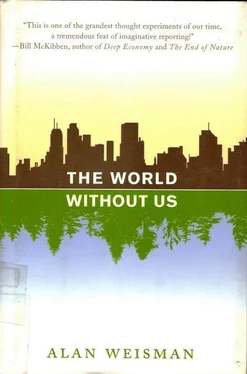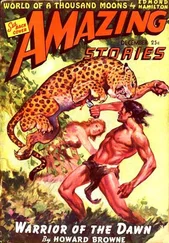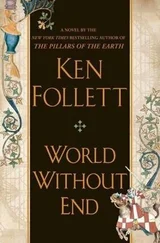
IN 1996, LONDON journalist Laura Spinney, writing in New Scientist Magazine , envisioned her city abandoned 250 years hence, turned back into the swamp it once was. The liberated Thames wandered among the waterlogged foundations of fallen buildings, Canary Wharf Tower having collapsed under an unbearable tonnage of dripping ivy. The following year, Ronald Wright’s novel A Scientific Romance jumped 250 years more, and imagined the same river lined with palms, flowing transparently past Canvey Island into a sweltering mangrove estuary, where it joined a warm North Sea.
Like the entire Earth, the posthuman fate of Britain teeters on the balance of these two visions: a return to temperate foliage, or a lurch into a tropical, super-heated future—or, ironically, into a semblance of something last seen in England’s southwestern moors, where Conan Doyle’s Baskerville hound once wailed into chill mist.
Dartmoor, the highest point in southern England, resembles a 900-square-mile baldpate with occasional massive chunks of fractured granite poking through, fringed by farms and patches of woods that exploded from old boundary hedgerows. It formed at the end of the Carboniferous Age, when most of Britain lay submerged, with sea creatures dropping shells on what became its buried chalk. Beneath that was granite, which 300 million years ago bulged with underlying magma into a dome-shaped island—which it may be again if seas rise as high as some fear.
Several ice ages froze enough of the planet’s water solid to drop ocean levels and allow today’s world to take shape. The last of these sent a mile-high ice sheet right down the Prime Meridian. Where it stopped is where Dartmoor begins. Atop its granite hilltops, known as tors, are remnants from those times that may be portents of what awaits if yet a third climatic alternative proves to be the British Isles’ destiny.
That fate could occur if meltwater from Greenland’s ice cap shuts down, or actually reverses, the oceanic conveyor atop which rides the Gulf Stream, which currently keeps Britain far warmer than Hudson’s Bay, at the same latitude. Since that much-debated event would be the direct result of rising global temperatures, probably no ice sheet will form—but permafrost and tundra could.
That happened at Dartmoor 12,700 years ago, the last time the global circulation system nearly slowed to a halt: no ice, but rock-hard ground. What followed is not only instructive, as it shows what the United Kingdom might resemble in coming years, but also hopeful, because these things, too, will pass.
The deep freeze lasted 1,300 years. During that time, water trapped in fissures in Dartmoor’s granite dome bedrock froze, cracking apart huge rocks below the surface. Then the Pleistocene ended. The permafrost thawed; its runoff exposed the shattered granite that became Dartmoor’s tors, and the moor bloomed. Across the land bridge that for another 2,000 years connected England to the rest of Europe, pine moved in, then birch, then oak. Deer, bears, beavers, badgers, horses, rabbits, red squirrels, and aurochs crossed with them. So did a few significant predators: foxes, wolves, and the ancestors of many of today’s Britons.
As in America, and Australia long before, they used fire to clear trees, making it easier to find game. Except for the highest tors, the barren Dartmoor prized by local environmental groups is another human artifact. It is a former forest repeatedly burned, then waterlogged by more than 100 inches of annual rainfall into a blanket of peat where trees no longer grow. Only charcoal remnants in peat cores attest that once they did.
The artifact was shaped further as humans pushed hunks of granite into circles that became foundations for their huts. They spread them into long, low unmortared stone reaves that crossed and hatched the landscape, and remain vivid even today.
The reaves divided the land into pastures for cows, sheep, and Dartmoor’s famous hardy ponies. Recent attempts to emulate Scotland’s picturesque heaths by removing livestock proved futile, as bracken and prickly gorse appeared rather than purple heather. But gorse befits a former tundra, whose frozen surfaces melt to spongy peat familiar to anyone who walks these moors. Tundra this may be again, whether humans are here or not.
Elsewhere on Earth, on former croplands that humans tended for millennia, warming trends will create variations of today’s Amazon. Trees may cover them with vast canopies, but the soils will remember us. In the Amazon itself, charcoal that permeates frequent deposits of rich black soil called terra preta suggests that, thousands of years ago, paleo-humans cultivated wide swathes of what we think of today as jungle primeval. Slowly charring rather than burning trees, they ensured that much of their nourishing carbon was not expelled into the atmosphere but was instead retained, along with nitrogen, phosphorus, calcium, and sulfur nutrients—all packaged in easily digested organic matter.
This process has been described by Johannes Lehmann, the latest of a lineage of Cornell University soil scientists who have studied terra preta nearly as long as the heirs to Rothamsted founder John Lawes have experimented with fertilizer. The charcoal-enriched soil, despite incessant use, never gets depleted. Witness the lush Amazon itself: Lehmann and others believe that it sustained large pre-Columbian populations, until European diseases reduced them to scattered tribes who now live off nut groves planted by their ancestors. The unbroken Amazon we see today, the world’s largest forest, rushed back so quickly across rich terra preta that European colonists never realized it was gone.
“Producing and applying bio-char,” writes Lehmann, “would not only dramatically improve soil and increase crop production, but also could provide a novel approach to establishing a significant, long-term sink for atmospheric carbon dioxide.”
In the 1960s, British atmospheric scientist, chemist, and marine biologist James Lovelock proposed his Gaia hypothesis, which describes the Earth as behaving like a super-organism, its soil, atmosphere, and oceans composing a circulatory system regulated by its resident flora and fauna. He now fears that the living planet is suffering a high fever, and that we are the virus. He suggests we compile a user’s manual of vital human knowledge (on durable paper, he adds) for survivors who may sit out the next millennium huddled in the polar regions, the last habitable places in a super-heated world, until the ocean recycles enough carbon to restore a semblance of equilibrium.
If we do so, the wisdom of those nameless Amazonian farmers should be inscribed and underlined so that we might attempt agriculture a little differently next time around. (There may be a chance: Norway is now archiving examples of the world’s crop seed varieties on an Arctic island, in hopes they may survive untold calamities elsewhere.)
If not, and if no humans return to till the soil or husband the animals, forests will take over. Rangelands that receive good rainfall will welcome new grazers—or old ones, as some new incarnation of Proboscidae and sloths replenish the Earth. Other places, however, less blessed, will have parched into new Saharas. The American Southwest, for instance: waist-high in grasses until 1880, when their cattle population of a half-million suddenly sextupled, New Mexico and Arizona now face unprecedented drought, with much of their water-retaining capacity lost. They may have to wait.
Still, the Sahara itself was once covered with rivers and ponds. With patience—though not, unfortunately, human patience—it will be again.
Читать дальше












